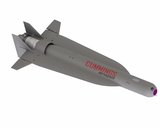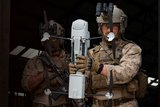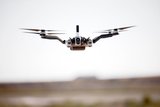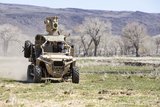Northrop Grumman poised to begin Titus UGV deliveries
Northrop Grumman has announced that its Remotec subsidiary will begin deliveries of the newest and smallest member of its Andros line of unmanned ground vehicles (UGVs) – Titus – in December. Details of the customer were not released in the 18 October announcement.
The Titus UGV has been designed for a variety of missions, and will bring a number of new capabilities to the small UGV market. According to the company, it was designed using a modular approach, which allows the robot to be quickly adapted for a variety of mission scenarios. Removable articulators, wheels and tracks provide users with the capability to navigate passageways that are only 16 inches wide and travel at a top speed of 7.5 mph. Industry standard interfaces such as USB and Ethernet make Titus easier to maintain and upgrade and to incorporate payloads and sensors.
The system weighs 135 pounds and measures 27 inches long, 16 inches wide and 23 inches high. It retains the four-articulator design that has given Andros vehicles advanced performance, and also features an operator control unit featuring a hybrid touch-screen and game system-style physical controls.
The company said attention has been paid to reducing life cycle costs, and to develop an operating system that provides greater information to the operator while easing user workload through more interactivity with intelligent payloads such as chemical, biological, radiological and nuclear sensors, along with preset arm positions and the ability to ‘fly the gripper,’ which makes manipulation of objects much easier.
Mike Knopp, director, Northrop Grumman Remotec, said that the feedback received so far from US and international military and first responders that have seen the system has ‘overwhelmingly validated’ that the company has achieved its objectives.
He added: ‘Titus represents the next-generation Andros. When we designed Titus, we challenged our engineers to not only retain certain capabilities but also to innovate and add capabilities – to really make the platform robust, highly functional and easy to use. They responded with a small UGV that was mechanically brilliant and re-imagined the entire user experience.’
More from Uncrewed Vehicles
-
![Cummings Aerospace showcases Hellhound loitering munition designed for US Army’s LASSO programme (video)]()
Cummings Aerospace showcases Hellhound loitering munition designed for US Army’s LASSO programme (video)
Cummings Aerospace presented its turbojet-powered Hellhound loitering munition at SOF Week 2025, offering a man-portable solution aligned with the US Army’s LASSO requirements.
-
![SOF Week 2025: PDW unveils attritable FPV drone for SOF operations at scale]()
SOF Week 2025: PDW unveils attritable FPV drone for SOF operations at scale
PDW has revealed its Attritable Multirotor First Person View drone at SOF Week 2025, offering special operations forces a low-cost, rapidly deployable platform for strike and ISR missions, inspired by battlefield lessons from Ukraine.
-
![SOF Week 2025: Teledyne FLIR white paper provides guidance on reusable loitering munitions]()
SOF Week 2025: Teledyne FLIR white paper provides guidance on reusable loitering munitions
Teledyne FLIR is highlighting the emerging requirements for 'recoverable and re-usable' loitering munitions across the contemporary operating environment during this week’s SOF Week conference in Tampa, Florida.
-
![SOF Week 2025: Kraken Technology group debuts K3 Scout USV in North America]()
SOF Week 2025: Kraken Technology group debuts K3 Scout USV in North America
High-performance maritime industry player Kraken Technology Group, based in the UK, has used the SOF Week conference in Tampa, Florida this week to debut its K3 Scout uncrewed surface vessel (USV) to the North American market.
-
![Palladyne AI and Red Cat to demonstrate capabilities for autonomous drone swarms to the US military]()
Palladyne AI and Red Cat to demonstrate capabilities for autonomous drone swarms to the US military
Red Cat and Palladyne AI recently conducted a cross-platform collaborative flight involving three diverse heterogeneous drones.
-
Jammer resistant drone designs spark search for countermeasures
The Russia-Ukraine conflict has driven another stage of evolution for drones and the counter measures to defend against them.
























